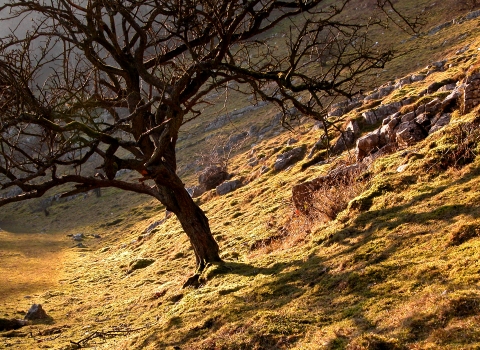
Bullfinch - Amy Lewis
Location
Know before you go
Dogs
Visit the 'Dog walking on reserves' page in the Contact section for more information.
When to visit
Opening times
Open at all timesBest time to visit
April to JulyAbout the reserve
Due to local soil conditions the grassland at the western end of the reserve is to a large degree dominated by a heathland flora with lots of Purple Moor-Grass, Heath Grass, Common Heather, Cross-Leaved Heath, Tormentil, Devil’s-Bit Scabious and Lousewort. Gorse also occurs in patches here. This type of heathland, known as Limestone Heath, is an uncommon habitat on the Mendip Hills.
A series of springs rise in this western field, turning into small streams, which flow to the southern boundary and give rise to a wonderful selection of wetland plant species such as Leafy rush, Common Cottongrass , Bog Pimpernel, Bog Asphodel, Bog Pondweed, Spring Sedge, Common Spike-rush, Toad Rush, Water Starwort, Marsh Thistle, Common Marsh Bedstraw, Marsh Violet and Lesser Spearwort.
Despite being so damp Brown Hares occur regularly, especially in areas of longer vegetation. Hazel Dormice are known to be present in the hedges, and the whole reserve is thought to be a significant hunting area for several bat species as there are several major caves roosts in the vicinity.
Snipe and Mallard regularly turn up in the damper areas of the reserve, while Redstart and Stonechat are recorded regularly as Summer visitors. Ravens and Buzzards nest locally. Bullfinches are frequent along the hedgerows.
Butterflies seen regularly include Meadow Brown, Gatekeeper, Ringlet and Green-veined White.
This reserve is an important site for dragonflies on the Mendip Hills due to scarcity of ground level water.
Reserve conservation management – Large areas of the reserve are managed as hay meadows, with an annual hay cut being taken in July followed by aftermath grazing with sheep and cattle. Other grassland areas are managed as permanent pasture, with grazing from late spring through to the end of summer. The large areas of gorse in the damper fields are being broken into smaller dense blocks, to provide a mosaic of habitats for birds, invertebrates and grassland wildflowers.
History and Archaeology - There are the remains of a farmhouse near the centre of the eastern boundary, which is known to date back to Medieval times. The current boundaries are thought to date back to the 18th Century Enclosure award.
There is also a restored Second World War bunker present on the northern boundary towards the east end of the reserve.
Lotts Grassland is also close to Burrington Coombe Gorge SSSI which lies a short distance to the north on the other side of Burrington Common which is itself a valuable heathland habitat. Blagdon Lake and Chew Valley Lake are also close.


